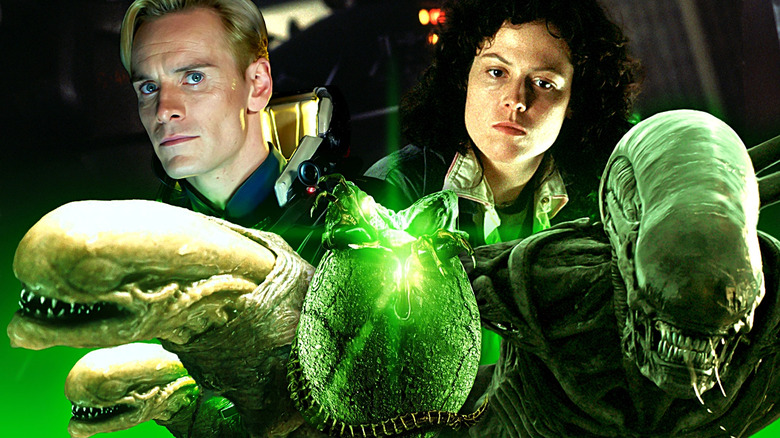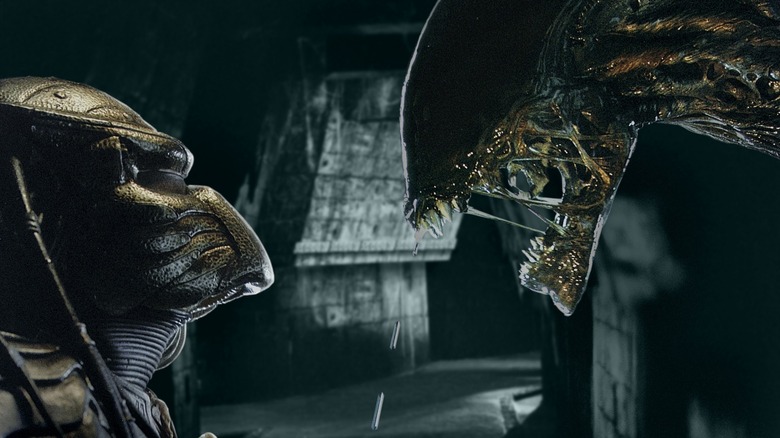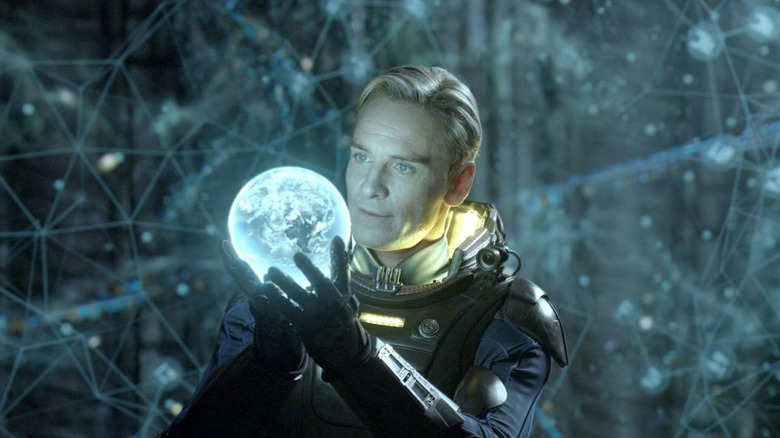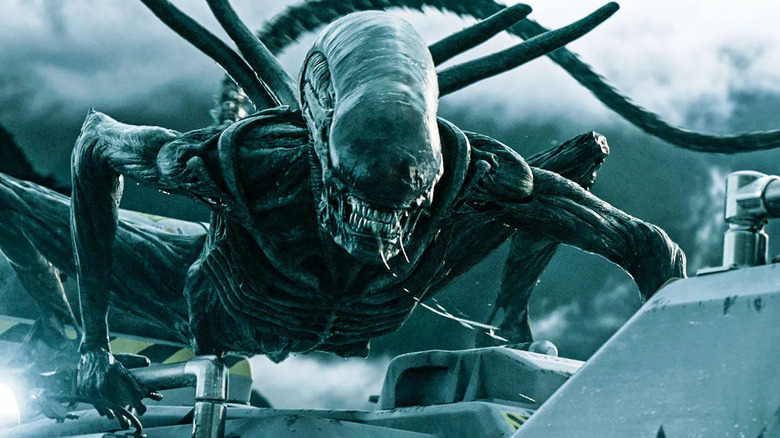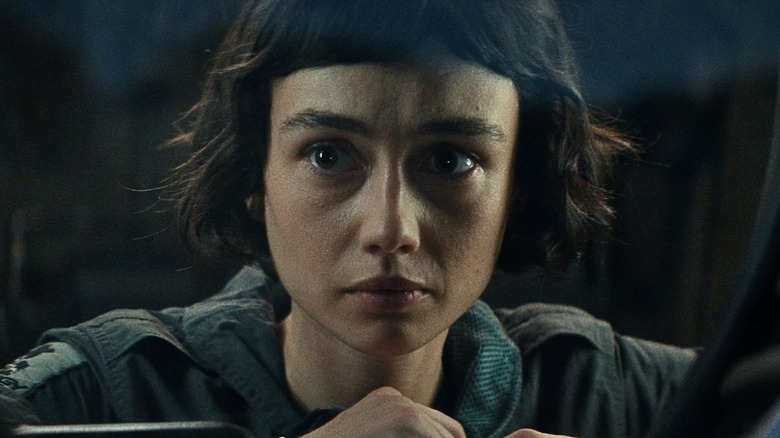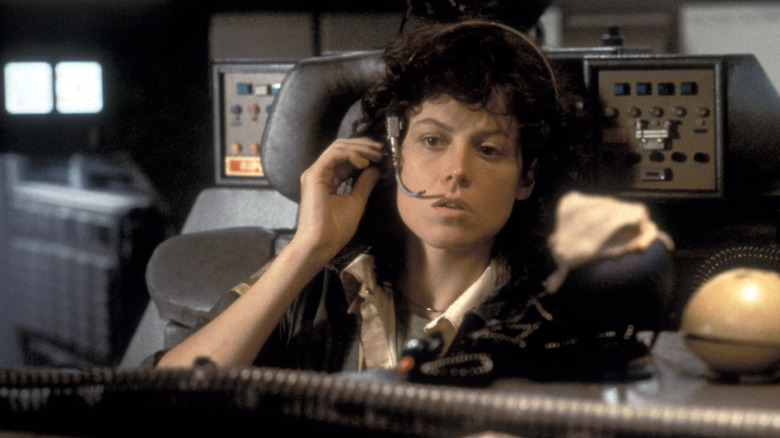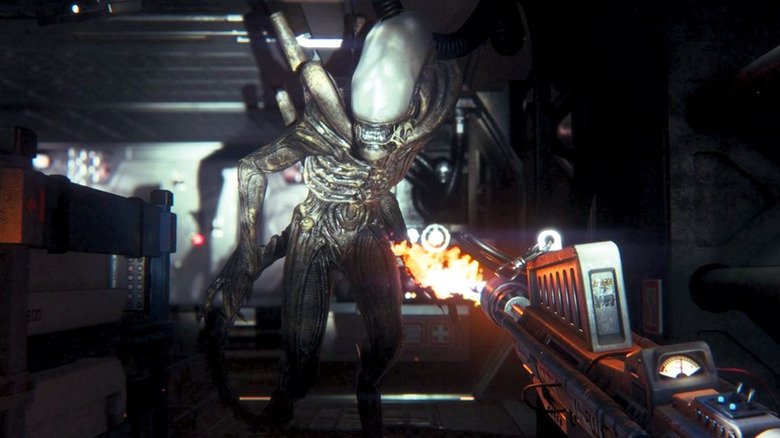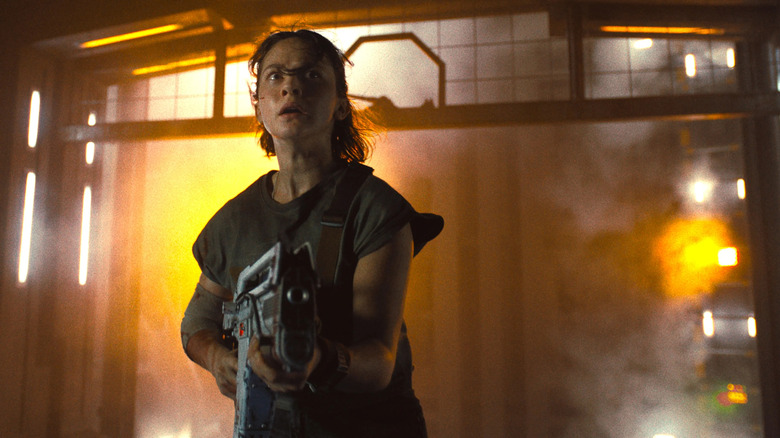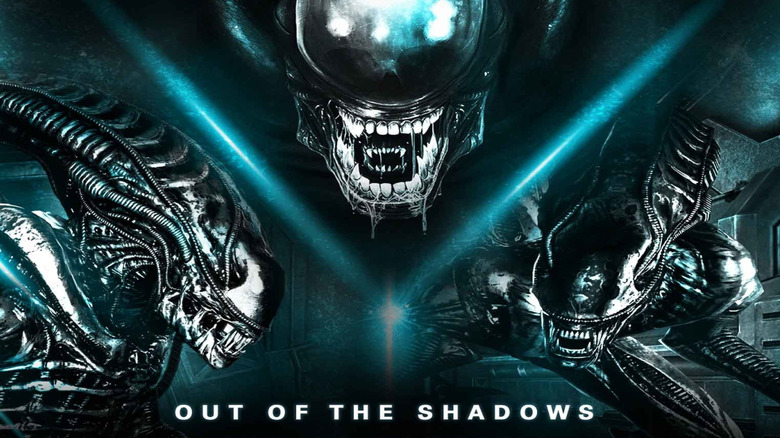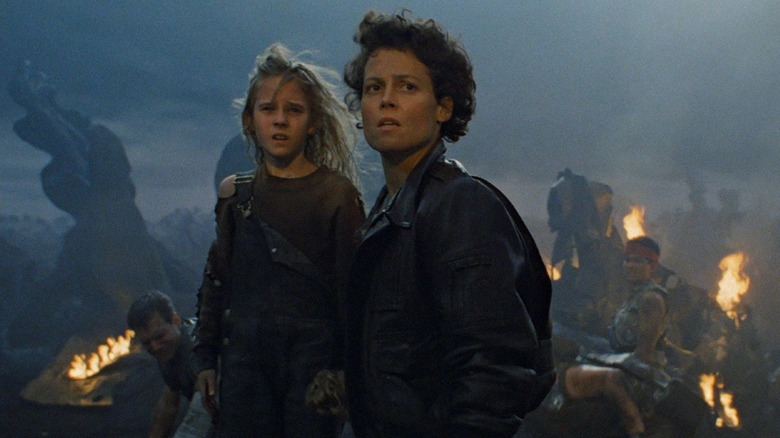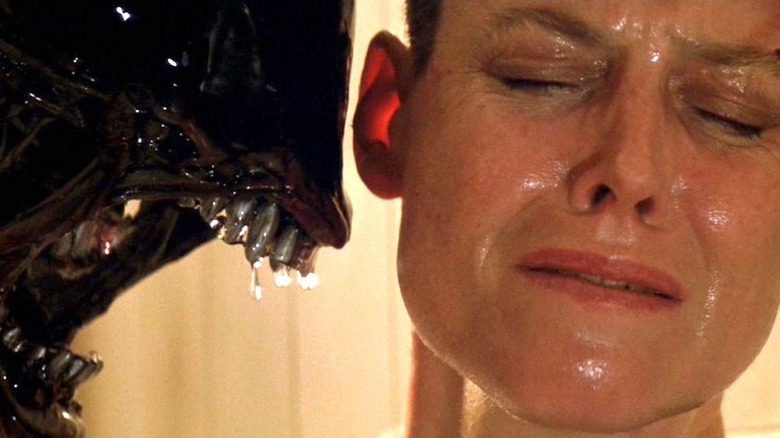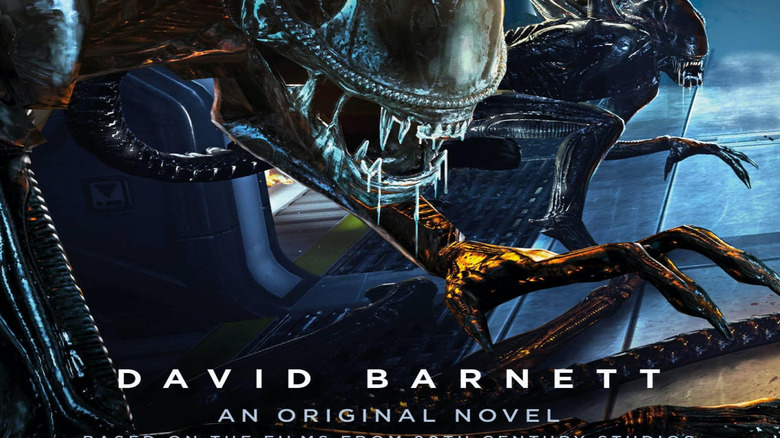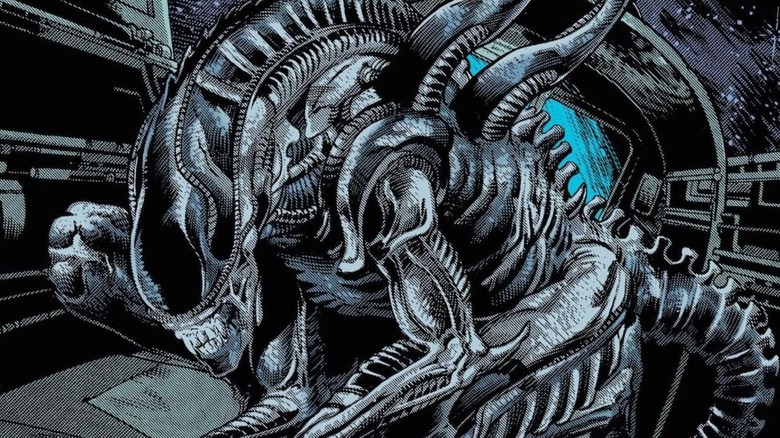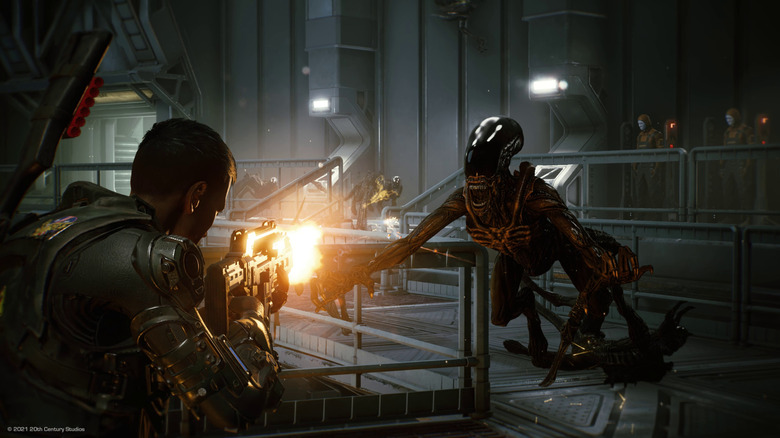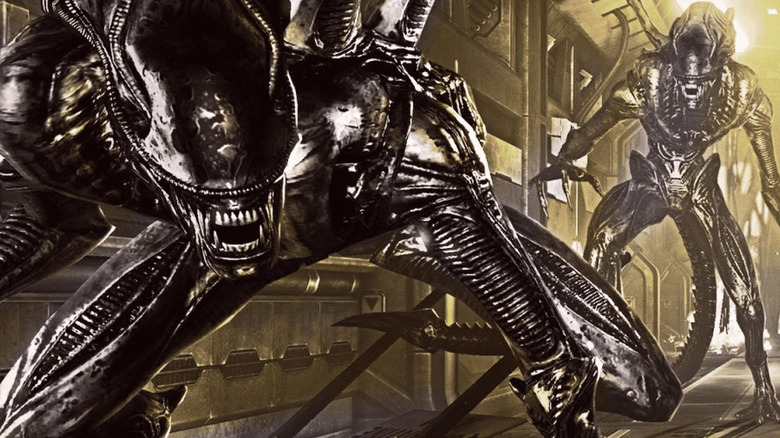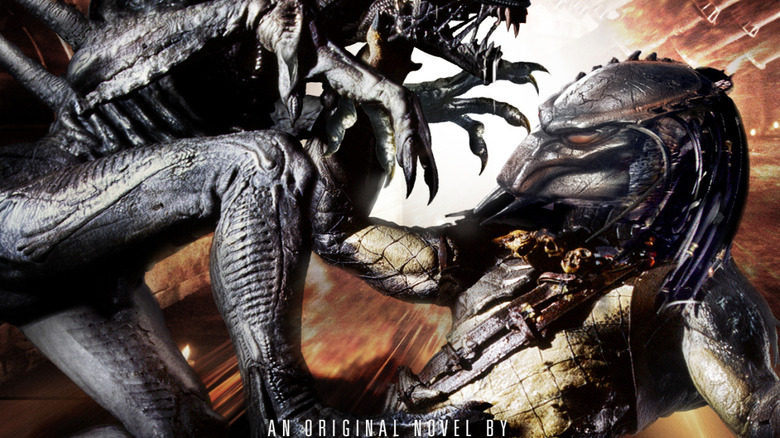The Entire Alien Franchise Timeline Explained
We may receive a commission on purchases made from links.
In the annals of cinematic history, few franchises can rival the longevity or creative variance of the "Alien" saga. Born from Ridley Scott's magnificent 1979 shocker "Alien," this sci-fi horror franchise introduced audiences to H.R. Giger's wonderfully nightmarish creature — the Xenomorph. A double-jawed monstrosity, drenched in slime and armed with acid blood, razor-sharp instincts, and a twisted form of intelligence, this so-called "perfect organism" has terrorized humanity across the galaxy for centuries.
While the creature's escapades have ranged from genre-defining highs ("Aliens") to unfortunate lows ("Aliens vs. Predator: Requiem"), the Xenomorph remains an astonishing cultural icon, continuing to haunt us through films, books, comics, and soon, an FX television series helmed by Noah Hawley.
Still, with so much material across so many mediums, it's easy to lose track of the timeline — or to wonder how one story connects to another. Fear not, the following article offers a deep dive into the entire "Alien" franchise timeline, making it easier to piece together the saga's sprawling history. Read on... if you dare.
2004 - AvP Era
Paul W.S. Anderson's "Alien vs. Predator" and Greg & Colin Strause's "Aliens vs. Predator: Requiem" were more or less wiped from the canonical timeline once "Prometheus" hit theaters, but we'll include them on the list just for reference's sake. Both films take place on Earth in 2004, marking the earliest encounter with the dreaded Xenomorph on our home planet.
Well, scratch that. According to "AvP," Predators constructed pyramids across the globe around 2,996 B.C., where aliens were bred and hunted for sport. Humans led by Charles Bishop Weyland (Lance Henriksen) discover a temple buried in Antarctica and wind up in the middle of a war between the two extra-terrestrial species. A fierce battle ensues, and a lot of people die in what amounts to a silly retread of better films.
Eventually, a group of Predators arrive and carry an infected Predator onto their ship, leading to the creation of the Predalien and the abomination known as "Aliens v Predator: Requiem." Naturally, amidst the chaos, the ship crash lands near Gunnison, Colorado, the Predalien escapes and gives birth to more aliens, which overrun the tiny town. Colonel Stevens, an agent of the Yutani Corporation, calls in a nuclear strike that wipes out the town, leaving only a handful of survivors to tell their tale in sequels that never came about because this movie was f****** awful.
As a side, a whole slew of "AvP" comics exist that do a much better job conveying this legendary conflict.
2023 - 2091 - Peter Wayland Files
Prior to the release of "Prometheus," Ridley Scott teased audiences with a series of promotional videos that added a little more context to the film's story and characters. Dubbed "The Peter Weyland Files," or "Weyland Archives," these short videos featured Guy Pearce as a young Peter Weyland delivering a philosophical TED Talk about the future of technology and humanity. Set in the year 2023, this brief speech references everything from the fallen god Prometheus to artificial intelligence and godhood, establishing the billionaire's desire to search the stars for our creators.
Another video features Michael Fassbender's David android model in a mock commercial highlighting his capabilities, manufactured personality, and emotional mimicry. A third introduces us to Noomi Rapace's Dr. Elizabeth Shaw and sees the plucky scientist reaching out to the Weyland Corporation to share her desire to find humanity's creators — likely the video that convinced Peter Weyland to recruit her for the "Prometheus" voyage.
Other fascinating tidbits released include a Weyland Industries timeline detailing the rise of the formidable tech giant, and a Weyland Corporation website containing extra lore like mission logs, staff profiles, and other fun details. Ultimately, the canonical "Alien" timeline begins here, leading to the "Prometheus" expedition in 2093.
2093 - Prometheus
Ok, we lied. If we really wanted to be nit-picky, the start of the "Alien" saga began billions of years ago, when an Engineer drank mysterious black goo that led to the creation of humanity — an episode seen at the beginning of Ridley Scott's very divisive "Prometheus." Flash forward to 2089, where Dr. Elizabeth Shaw and a team of archaeologists discover an ancient cave on the Isle of Skye with coordinates that guide them to the Engineers. Somewhere between this moment and the start of "Prometheus" in 2093, Shaw sends her message to the Weyland Corporation and joins the Prometheus expedition.
In the film, Shaw and the ill-fated crew of the Prometheus discover an Engineer ship on the moon LV-223, along with a substantial arsenal of black goo that appears to have been created to wipe out humanity. Another struggle commences — one filled with numerous nonsensical plot contrivances, many of which are concocted by the maniacal android David — and everyone except Shaw and David is killed. Our pair of survivors then boards another Engineer ship and flies off into space, seemingly intent on locating the Engineer home world.
We also get a good look at an early Xenomorph, known in canon as the Deacon, created after Shaw's alien baby — it's a long story — sucks face with an Engineer. Presumably, the Engineers designed the aliens as bioweapons; a foolhardy errand that left plenty of their own on the wrong side of mortality.
2104 - Alien: Covenant
Here's where the fun really begins. Set roughly a decade after the events of "Prometheus," "Alien: Covenant" continues the exploits of David, the evil synthetic hell-bent on enacting revenge against his creators — namely, humanity. Using research gained by studying the Engineers, David genetically creates the ovomorph (egg) and facehugger by experimenting on the Engineers and other lifeforms (including Dr. Elizabeth Shaw) by using the black goo taken from LV-223. He then sends a signal that beckons the crew of the USCSS Covenant to his location on Planet 4, the Engineers' home world.
Led by Chris Oram (Billy Crudup) and Daniels (Katherine Waterston), the Covenant crew discovers David's crashed ship and learns how he annihilated the local inhabitants. Eventually, they fall into the vile android's trap and become part of his cruel experiments that lead to the Neomorph and later the Protomorph — the latter of which looks very similar to the classic monster seen in the original "Alien."
As of now, we don't know David's fate. "Covenant" concludes with him in control of the titular ship, including Daniels and Tennessee (Danny McBride), who will likely now figure into his experiments. Ridley Scott has already stated that he has nothing left to offer the franchise, but this is certainly a storyline in dire need of a conclusion.
2120 - Alien: Earth
Now we jump to FX's "Alien: Earth." Set two years before "Alien," in 2120, the TV series follows a group of tactical soldiers as they explore a crashed ship likely carrying the dreaded Xenomorph. While we don't know much about this fascinating project, creator Noah Hawley has stated his desire to ignore the events of "Prometheus" and "Alien: Covenant," instead focusing on the mythology of "Alien." Judging by the early trailers, he appears to have achieved his objective.
Starring Sydney Chandler, Timothy Olyphant, Alex Lawther, Essie Davis, Lily Newmark, and Samuel Blenkin, "Alien: Earth" has already unveiled a series of captivating trailers that promise to deliver the franchise's trademark creepy horror vibe, along with a few new twists. If we had to guess, it's likely the events that transpire in the series set in motion the Weyland-Yutani Corporation's desire to capture the Xenomorph, leading the dreaded company to send the USCSS Nostromo on its ill-fated mission into space.
According to several sources, the Nostromo departed Earth in 2120 — the same year "Alien: Earth" is set. A few years later, Ellen Ripley (Sigourney Weaver) will come face-to-face with the alien for the first time.
2122 - Alien
Now we go back to 1979, er, jump forward to 2122, where it all began, with Ridley Scott's classic box office hit "Alien." Here, audiences met series icon Ellen Ripley and the Xenomorph for the first time, encountered the mysterious Space Jockey (later retconned as an Engineer), and learned that androids — even those played by Ian Holm — could pose a greater threat than a slimy, double-jawed extraterrestrial.
Events kick off when the USCSS Nostromo, headed back to Earth after a deep-space mission, receives a distress signal from the moon LV-426. The ragtag crew sets foot on the desolate rock and discovers a crashed spaceship — one we now know belonged to the Engineers. Inside, they come across thousands of eggs, one of which springs to life and infects Kane (John Hurt), who subsequently "gives birth" to the alien. You know the drill: the creature grows, stalks, and kills the crew one by one until only Ripley is left standing, leading to a thrilling showdown that ends with the alien blasted into space. Following her encounter, Ripley enters hypersleep in the Narcissus and drifts away into the dark reaches of space, presumably en route to Earth.
By now, this formula is part and parcel of the franchise. In 1979, however, audiences practically fainted over Scott's gnarly sci-fi horror. "Alien" set the course for a fascinating — and often frustrating — franchise that has yet to clear the high bar set by its first two entries.
2137 - Alien: Isolation
It took 35 years, but we finally received a solid third entry in the "Alien" franchise: 2014's "Alien: Isolation." Developed by Creative Assembly, this survival horror video game adventure follows Ellen Ripley's daughter, Amanda (Andrea Deck), who travels to the space station Sevastopol in 2137 to retrieve the "Nostromo"'s flight recorder and uncover the truth about her mother's disappearance. Naturally, she arrives to find a ravaged station populated by a handful of terrified survivors — and one very nasty alien.
Apparently, a small crew recovered the derelict ship's coordinates from the flight recorder and set off for LV-426. As expected, their expedition results in a Xenomorph being brought aboard Sevastopol. Amanda must sneak through the sprawling facility, evading the alien while also contending with rogue androids and desperate, armed civilians in order to survive. The game ends with her destroying Sevastopol and drifting into space. Though her ultimate fate is left ambiguous in the game, "Aliens" later reveals that Amanda Ripley died on December 23, 2178.
An exciting love letter to Ridley Scott's classic, with a few nods to James Cameron's "Aliens" thrown in for good measure, "Alien: Isolation" leans heavily on established lore without upending the formula. A semi-sequel titled "Alien: Blackout" was released for mobile devices in 2019, and a pair of comic book sequels continued the storyline. As of 2024, Creative Assembly has confirmed development of a full sequel.
2142 - Alien: Romulus
A lot happened during Ellen Ripley's long, 57-year voyage through space — including the events of Fede Álvarez's "Alien: Romulus." Set in 2142, or 20 years after "Alien," the film follows a young group of Weyland-Yutani workers and their encounter with a whole slew of aliens aboard the derelict space station Renaissance. Led by the fearless Rain Carradine (Cailee Spaeny) and her android companion (and "brother") Andy (David Jonsson), the group hopes to steal the Renaissance's cryostasis equipment and escape their bleak existence on the planet LV-410.
Surprise, surprise! The Renaissance is crawling with aliens genetically derived from the Xenomorph seen in Ridley Scott's 1979 film. But wasn't that creature launched into space by Ripley? Yup. However, a Weyland-Yutani probe supposedly retrieved the organism from the Nostromo's wreckage, where it had cocooned itself to survive. (Just go with it.) Scientists then used the alien's DNA to reverse-engineer facehuggers, a project that quickly went sideways, killing the station's original crew along with the original Xenomorph.
We learn all of this from the Renaissance's science officer, Rook — an Ash lookalike obsessed with "saving" humanity by using fluid harvested from the facehuggers to genetically enhance humans for deep-space survival. It's just one of several callbacks and plenty of Easter Eggs from the original "Alien" and beyond.
Rain and Andy survive the ordeal after battling a grotesque Engineer/Xenomorph hybrid and set off into space, setting up a planned sequel. Oh, and in one final twist, they unknowingly brush shoulders with Ripley herself.
2159 - 2179 - Out of the Shadows, River of Pain
Now we get to "The Shadow Archive," a trilogy of books loosely tied together (though the third entry, "Sea of Sorrows," occurs in 2496).
First up is "Alien: Out of the Shadows", set around 2159, roughly 37 years after the events of "Alien." A mining vessel, the DSMO Marion, orbiting the planet LV-178, experiences a Xenomorph outbreak that cripples the ship and knocks it out of orbit. The surviving crew, including Chris Hooper, sends out a distress signal which is intercepted by the Narcissus.
Ripley is awakened and must help her newfound allies escape the Marion before it crashes into the planet, all while dealing with a dangerous complication: Ash's consciousness, preserved as an AI fragment within the Narcissus. In the end, Ripley is knocked unconscious. Hooper, fearing the psychological damage this second encounter might cause her, erases her memory and places her back into hypersleep — none the wiser. Convenient.
Meanwhile, "Alien: River of Pain" chronicles the fall of Hadley's Hope, the ill-fated colony established on LV-426. The story follows Rebecca "Newt" Jorden and her family after Carter Burke (Paul Reiser) orders colonists to investigate the Derelict spacecraft from "Alien." This leads to the first facehugger infection and, inevitably, a full-blown alien outbreak. As the colony descends into chaos, Newt is left to fend for herself. The novel ends where "Aliens" begins with the Colonial Marines being dispatched to Hadley's Hope. A comic adaptation, "Newt's Tale," is also available.
2179 - Aliens
It's fair to say the "Alien" franchise peaked with its first two installments. While James Cameron's "Aliens" jettisons much of the horror atmosphere of Ridley Scott's "Alien" in favor of a more straightforward action-adventure, it remains a classic follow-up and easily one of the greatest sequels ever made.
Set in 2179, "Aliens" sees Ellen Ripley's long journey back to Earth finally come to an end 57 years later. Forever plagued by Xenomorph nightmares, our badass protagonist joins a crew of Colonial Space Marines on a mission to investigate the Hadley's Hope colony on LV-426, which has gone radio silent. There, Ripley finds Newt and a whole hive of Xenomorphs that quickly make mince meat of her supporting cast. Together with a meager band of survivors, notably Hicks (Michael Biehn, who now holds a rare cinematic honor), the android Bishop (Lance Henriksen), Hudson (Bill Paxton, who has a similar honor as Biehn), and Vasquez (Jenette Goldstein), Ripley fights like hell to survive, nuking LV-426 in the process.
Eventually, she comes face-to-face with an Alien Queen, and the two mortal enemies engage in a brutal battle — with Ripley using a power loader to fend off her massive foe. Ultimately, Ripley tosses the Queen into space, and once again settles into hypersleep alongside Newt, a wounded Hicks, and Bishop.
"Alien" firmly established the franchise, but "Aliens" takes those ideas to a whole new level, delivering a sharp, fast-paced action extravaganza that has yet to be topped by any entry released in the last 40 years.
2179 - Alien 3
Ellen Ripley's third hypersleep journey ends far sooner than the previous two, thanks to a random (read: nonsensical) egg the Alien Queen somehow left behind on the Sulaco during the climactic battle in "Aliens." A facehugger emerges, chaos ensues, and Ripley, Newt, Bishop, and Hicks are ejected in an escape pod that crash-lands on the remote penal colony planet Fiorina 161.
Directed by David Fincher – who has since publicly disowned the project after a troubling production — "Alien 3" drags the franchise into bleak, nihilistic territory. Fan favorites like Hicks and Newt are killed off-screen, during the opening credits, leaving Ripley once again facing the alien threat alone, aided by a group of violent prisoners.
The twist? Ripley is carrying an Alien Queen embryo inside her chest. This leads to a powerful (and divisive) finale in which she sacrifices herself by leaping into a vat of molten metal, ensuring the alien species dies with her.
End of story, right? Well, not exactly.
In the 2013 video game "Aliens: Colonial Marines," it's revealed that Hicks didn't actually die in the escape pod crash. According to the game, he was rescued by Weyland-Yutani personnel, who swapped his body with another unknown victim and detained him at a black site for interrogation.
2180 - 2187 - Colony Wars
The next seven years are quite eventful in the "Alien" universe. During this era, Michael Bishop repairs the synthetic Bishop, upgrading him with a stronger body that allows him to continue fighting Xenomorphs alongside a contingent of Colonial Marines — events chronicled in the novel "Aliens: Bishop."
A few years later, in "Alien: Into Charybdis" (2184), a war breaks out after a group of American engineers arrives at an Iranian-run facility on LV-991, inadvertently triggering a Xenomorph outbreak tied to secret Weyland-Yutani experiments. These events carry over into "Alien: Colony War" (2186) and introduce characters such as Shy Hunt and her sister Cher. The story explores the far-reaching implications of Weyland-Yutani's dangerous experimentation on the alien species, which invariably leads to dire consequences.
In 2186, "Alien: Inferno's Fall" depicts colonists on the mining planet Shānmén transforming into Xenomorph-like creatures after exposure to a mysterious black rain. This catastrophe prompts an elite team known as the Jackals, led by Zula Hendricks, to intervene and search for survivors. "Alien: Enemy of My Enemy" (2187) continues the story, focusing primarily on the political aftermath of the events in "Inferno's Fall."
These stories take a deep dive into the state of the universe, where wars among various factions play an integral role in the ongoing Xenomorph threat.
2195 - 2295 - Comics
Oddly, the next several hundred years are largely overlooked — except in comic books. These standalone stories primarily explore Weyland-Yutani's relentless pursuit of profit and power, often at the expense of human life and morality. Their obsession with weaponizing the Xenomorph leads to reckless experimentation, death, and widespread catastrophe. Many comics continue themes introduced in the novels, diving into the conflicts between warring colonial factions, usually set amid a Xenomorph outbreak.
In other words, Ellen Ripley wasn't the only one whose life was screwed over by the Xenomorph.
High points include "Alien: Thaw" (2195), which perfectly captures the original "Alien" vibe, and "Alien Vol. 1: Bloodlines" (2200), an exciting story with strong characters that continues into "Alien: Revival" (2202). Other entries such as "Alien: Icarus" (2205), "Alien: Descendant" (2208), "Aliens: Aftermath" (2214), and "Aliens: Dead Orbit" (2295) fill in the narrative gap between "Alien 3" and "Alien Resurrection," further expanding the universe.
For more of an "Aliens" vibe, check out "Aliens: Earth Hive" (2192), or its earlier version, "Aliens: Outbreak," along with its two follow-ups: "Aliens: Nightmare Asylum" (2189) and "Aliens: Female War." These stories were originally intended as direct sequels to "Aliens" and continue the adventures of Hicks and Newt — offering a far more satisfying progression than "Alien 3." Alternatively, for a different take on the third film, read William Gibson's original script, which has since been adapted into both a comic and a novel.
2198 - 2200 - More Video Games
Gamers in need of a Xenomorph fix can jump into "Aliens: Dark Descent" (2198), which picks up 19 years after the original "Alien" trilogy and follows Colonial Marines as they try to stymie an outbreak on the moon Lethe, triggered by the dangerous Darwin Era cult. Led by Sergeant Jonas Harper, the badass squad chases down the cult's leader, a rogue Weyland-Yutani scientist named Joseph Marlow, and deals with everything from telepathic daughters to an ancient alien city. Like all good Alien stories, our heroes nuke the site from orbit and head off into deep space. (Seriously, fans of "Aliens" should check out this game.)
"Aliens: Fireteam Elite," a solid survival horror experience set in 2202, similarly features a squad of Colonial Marines battling Xenomorphs across multiple worlds. The mission begins on the orbital refinery station Katanga, where Weyland-Yutani foolishly experimented with alien eggs and a mutagen called the Pathogen. The squad must stop a rogue AI from launching an Engineer ship loaded with Pathogen to Earth, all while fighting through wave after wave of Xenomorphs in a variety of terrifying locations.
Backing up slightly, the VR game "Alien: Rogue Incursion" (2140) places gamers in the shoes of Zula Hendricks, an ex-Colonial Marine fighting to survive an alien infestation on the remote mining planet Purdan. The first part of a two-part story, Zula kills an Alien Queen only to be attacked by a synthetic, leaving her fate undetermined.
2381 - Alien Resurrection
Over 200 years after "Alien 3," military scientists figure out a way to clone Ellen Ripley, bringing the tough-as-nails heroine back from the dead in "Alien Resurrection."
Well, kind of.
Ripley 8, as she's known, carries alien-like attributes. She can feel the beasts moving aboard the space vessel USM Auriga and shows a complete lack of empathy toward her human companions. Unfortunately, this solid premise falters under director Jean-Pierre Jeunet's over-stylized direction and Joss Whedon's clunky screenplay. While this bonkers entry works as a serviceable B-movie creature feature, it fails to capture the elegance, and ferocity of previous entries.
At one point, Ripley has sex with an alien — yes, really! — which gives birth to a nasty looking human/Xeno hybrid, a concept that fails to deliver due to a truly heinous animatronic. A fight ensues, the hybrid is sucked out into space, and our heroes land on Earth — a finale that bugged Whedon — setting up a would be sequel that never happened after awful ticket sales.
No matter, the story lives on in "Aliens: Original Sin," a 2005 novel written by Michael John Friedman introduces a shadowy group called Loki that spends its days orchestrating Xenomorph outbreaks in exchange for advance tech. Ripley and her motley crew live to continue their fight against this newfound enemy. And this, dear readers, is where Ripley's story ends ... for now.
2496 - Sea of Sorrows
Continuing our journey into the later stages of the "Alien" universe, "Alien: Sea of Sorrows" follows Ripley 8's descendant, Alan Decker, who also shares a unique connection to the Xenomorphs, as he tries to stop Weyland-Yutani from once again acquiring a specimen. Yes, that's right, hundreds of years later, and this friggin' company is still trying to weaponize this deadly alien species, despite centuries of carnage and catastrophe. Take the hint already!
Plot twist: This time, they actually succeed. The novel ends on a chilling cliffhanger as Weyland-Yutani secures a live Xenomorph, clearly planning to continue their experiments, likely toward creating bioweapons or advancing biotech. At this point, we're not even mad. Like Wile E. Coyote chasing the Road Runner, the company has been at this for so long that you kind of start rooting for them just to see what happens.
Unfortunately, Alan Decker hasn't reappeared since. He ends his story debt-free and en route home, but whether his actions made any real difference remains unclear, making it hard to feel too broken up when you turn the final page. At the very least, this book concludes the "Shadow Archive," even if the stories are very loosely connected.
2500 - Aliens: Phalanx
"Aliens: Phalanx" (roughly 2500), a novel by Scott Sigler, remains a crucial piece of lore for "Alien" fandom, as we finally see humanity figure out how to push back against the dreaded Xenomorphs — ironically, using very primitive methods.
Far into the future, the story's heroes — Ahiliyah, Brandun, and Creen — are inhabitants of the planet Ataegina, which is stuck in a feudalistic state. They spend their days fighting off "demons" (Xenomorphs) that dwell in nearby Black Smoke Mountain. Ahiliyah's people have battled these monsters for generations, passing down knowledge of their existence through myth and oral tradition. As the conflict grows deadlier, the trio meets Zachariah, a synthetic who reveals that a colony ship carrying Xenomorphs crash-landed on Ataegina approximately 300 years earlier — roughly around the end of the original "Alien" trilogy.
Ahiliyah eventually discovers a way to thwart a Xenomorph outbreak using caminus leaves, a natural substance that destroys embryos and can be turned into a paste capable of killing full-grown aliens. By those measures, "Phalanx" is a rather important entry in the franchise — even if the key revelations sprinkled throughout its plot may feel like too little, too late.
2351 - 2692 - The Rage War Trilogy
Chronologically speaking, "The Rage War Trilogy" represents the furthest point in the "Alien" timeline, kicking off with "Predator: Incursion" in 2351 and concluding with "Alien vs. Predator: Armageddon" in 2692. This series exists in a separate continuity within the "AvP" universe, but it's a fun way to bookend an article that began with the "AvP" film.
Additionally, this trilogy offers a glimpse into the state of the universe hundreds of years after Ellen Ripley's departure, highlighting Weyland-Yutani's continued obsession with the Xenomorphs and introducing a transhuman faction known as The Rage. These enhanced humans bio-engineer the aliens into a devastating weapon, prompting an unlikely alliance between humans and Predators to stop them.
The conflict escalates in "Alien: Invasion" (Book 2), where the franchise's core themes of corporate greed and biological weaponization are echoed and amplified across the galaxy. Finally, "Alien vs. Predator: Armageddon" culminates in an epic showdown that spans multiple colonies and Earth itself.
The climactic battle successfully eliminates The Rage and sees humanity and the Predators go their separate ways — though the uneasy peace leaves the door open for future conflict. Basically, this saga will never end as there always exists one or two nut jobs willing to utilize the Xenomorphs for their own personal gain.
